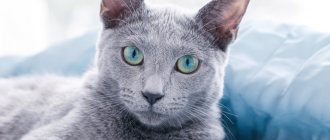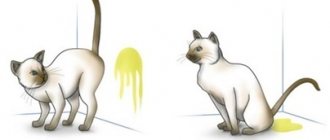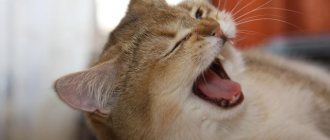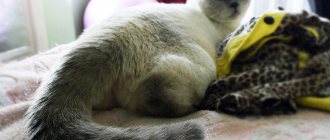Owners of cats often have to watch their pets sneeze or snort. In this case, a cat’s sneezing can be either one-time or multiple. Sneezing itself in cats, like in humans, has a protective function. However, if this physiological process in a cat becomes permanent, the owner needs to pay close attention to the health of his pet. Are there any additional symptoms that are bothering the cat? If these symptoms and lethargy are detected, you should immediately contact a veterinarian.
Main reasons
Why does a domestic cat sneeze? An absolutely healthy pet does not sneeze so often, usually 1-2 times a day or about 5 times a week.
Severe pathology is sneezing more than 2 times a day, cascading sneezing, various substances discharged from the nose, the presence of associated symptoms - coughing, wheezing, refusal to eat, lethargy, high fever.
A cat sneezes - why is it dangerous?
- Sneezing is a beneficial function of the body in which it forcefully expels irritants from the nose.
- However, if your cat's sneezing does not go away, or if other symptoms occur along with the sneezing, you may need to consult your veterinarian to find out how dangerous it is.
Because viral, bacterial or fungal infections of the upper respiratory tract, which are characterized by symptoms such as constant sneezing, nose, eyes, etc., are contagious to people.
Free consultation Moscow
+7(495)162-70-70
Foreign object
Our fluffies quite often sniff surrounding objects (especially new ones), and can inhale dust, hairs and their undercoat, particles of litter, small threads, and so on.
The nasal canals of cats are thin, for this reason the smallest object clogs the passage, thereby severely irritating the mucous membrane. And then the cat begins to sneeze reflexively.
This situation can be identified by the following signs:
- The cat snorts;
- Repeatedly scratches nose with paws;
- Rubs a certain part of the muzzle against other objects, furniture, etc.;
- Constantly sneezes.
In this situation, discharge may form - usually it is a slightly thick transparent mucus. This is a natural defense of the body that helps clear the nasal passage. If the mucous membrane is damaged, then ichor or blood may be present in the mucus.
First aid for a sneezing cat
In the vast majority of cases, the cause of a sneeze in a cat is a common runny nose after hypothermia, due to a cold. At home, you can alleviate your pet's condition by rinsing the nasal passages. This procedure will help cleanse the mucous passages from possible allergens. In order to cleanse the nasal passages, it is recommended:
- Take the rinsing solution and warm it to room temperature. A saline solution sold in pharmacies for newborn babies is suitable.
- Draw the solution into a syringe with the needle previously removed, and using a towel to secure the cat on its side in a lying position, pour a little liquid into one, then into the other nostril.
- It is very important to take a short break before pouring the next portion of the solution. This is necessary so that the animal has time to get rid of the remains.
- At the end of the procedure of washing the nasal passages, you can blot your nose with a dry soft napkin and release the animal.
You can independently rinse your cat’s nasal passages with saline solution at home only if you have previously consulted with a veterinarian. The fact is that sneezing can be caused by a foreign body, and rinsing leads to the pushing of foreign particles into the deep parts of the respiratory system.
The best solution would be to take the animal to a veterinary hospital. The specialist will conduct a detailed examination and prescribe a series of studies to identify the main reason that provoked the development of a specific reflex for clearing the nasal passages.
Cold
Colds are provoked by different types of viruses, the symptoms are similar to those of humans - cough, periodic sneezing, mucous discharge from the nasal canals.
- If the cold is advanced, the cat begins to breathe through its mouth.
- The temperature rises in rare cases, but the nose noticeably dries out and becomes hot, which is why cracks often appear on it.
- The cat doesn’t like this at all, and she tries to lick her nose often in order to somehow wet it.
Colds in pets, as a rule, last no more than 4-5 days, after which the inflammatory phenomena gradually subside. A sick pet has difficulty distinguishing and perceiving odors.
Visit to the veterinarian
Immediate medical intervention is required only in case of strange, suspicious behavior of the animal. The following symptoms should cause particular concern:
- lethargy;
- runny nose and cough;
- lack of appetite;
- hot nose;
- heat;
- teary eyes.
Treatment will depend on the cause of the sneezing. If it is a foreign object, the doctor will be able to remove it. Colds and infections will require medication.
Allergy
Allergies can also be a common reason why a cat starts sneezing; common allergens are:
- Dust mites;
- Pollen and juice of various plants;
- Various preservatives in industrial feeds;
- Household chemicals (detergents, powders, etc.).
Symptoms of an allergic reaction are frequent sneezing, the flow of various fluids from the nose and eyes, conjunctivitis, and regular scratching. If the allergic reaction is very strong, then the cat scratches the skin a lot, this may cause some of the hair to fall out, and sometimes large bald patches will form.
To prevent allergies in a cat, you need to eliminate the source of the allergen. If you are unable to find it yourself, then you need to contact a veterinary clinic for examination.
Pathological causes of cat sneezing
Among the factors that provoke sneezing in a cat are a number of pathological ones. Before starting therapy, the doctor always conducts diagnostic tests to find out the cause of sneezing.
The main pathological causes of sneezing in cats are:
- Allergic type reactions. When the mucous membranes are irritated by allergens, frequent sneezing occurs. The cause of such an allergic condition can be various household chemicals, particles of which float in the air, detergents, oils and scented candles, and air fresheners.
- Colds. The cause of a cold is most often hypothermia of the body and a decrease in immune strength. In addition to sneezing, the cat has a runny nose and an increase in body temperature.
- Infectious lesions. Various fungal, bacterial and viral infections often affect the animal's respiratory tract. There is also discharge from the eyes, increased body temperature, and a severe cough.
- Helminthiases. Some types of worms can affect the respiratory tract. Settling in the respiratory organs, helminthiases are characterized by rapid breathing, runny nose, attacks of nausea and vomiting. Against the background of long-term infection with worms, the animal loses weight, and exhaustion of the body may occur. All helminthiases, in the absence of timely treatment, lead to the development of serious changes in the body, the main of which is a decrease in the body’s immune forces.
Infection
If your pet begins to sneeze frequently, this is one of the first symptoms of inflammatory processes in the animal’s respiratory system. A cat can catch infections caused by fungi, viruses or bacteria.
With such diseases there are symptoms that appear parallel to a sneeze:
- Cough, heavy breathing with a barely noticeable whistling;
- The pet begins to discharge pus from the eyes;
- High body temperature of the animal;
- Prolonged neglect of water and food;
- Wet spots on the face, the cat rubs it on pieces of furniture and scratches it with its paws.
In this case, self-medication is unacceptable; you should contact the clinic so that a qualified veterinarian can prescribe treatment.
Preventing sneezing in cats
In order to prevent your tailed pet from getting sick, you should follow simple maintenance rules: eliminate drafts in the house, provide your pet with a warm place to sleep, change the litter in the tray or change the diet if an allergy is detected. It is also necessary to carry out timely cleaning of the house and not to spray chemicals near the pet. It is advisable to install a humidifier for it. If your cat is sick, there is no need to disturb him again; it is better to give him more water and follow the treatment prescribed by the doctor.
Under no circumstances should you self-medicate, this is fraught with complications that can lead to serious consequences!
You should also visit your veterinarian annually for examinations and vaccinations. Do not allow your pet to come into contact with stray animals. Once every three months, treatment for parasites should be carried out. And of course, the most important thing is to surround your pet with your love and care!
Asthma
The first symptoms of asthma in cats are noticeable in childhood. When an attack occurs, the kitten sneezes, sniffles, wheezes, and breathes with its mouth open. After such attacks, the pet can lie in a secluded corner for 3-4 hours, while not approaching water or food.
- Adult cats with asthma have a poor coat, appear thin and lethargic, and do not show much activity.
- Anything can trigger an attack - dust, detergents, a change of environment.
You need to understand that this disease cannot be treated, so the owner and pet will have to live with it all their lives; only drugs are used that reduce the frequency of attacks or alleviate them.
How to prevent cat sneezing
As we found out, sneezing is only a symptom of some illness. To prevent a cat from suffering from constant “Apchhi”, you need to:
- If your pet is sneezing due to an allergy, it is important to determine what is causing the pathological reaction. Once the allergen is identified, it will be necessary to eliminate or minimize its presence in the room where the pet lives;
- Infection cannot always be avoided, but it is better to exclude the cat from communicating with stray animals. For some ailments (such as rhinotracheitis), cats are given vaccinations, which help develop immunity to infectious agents;
- The apartment where an asthmatic cat lives must be crystal clean and regularly ventilated. Tobacco smoke should be avoided;
- Worms poison not only the respiratory system, but also the intestines, stomach, heart and other important organs. Cats are dewormed once a quarter (twice with a 14-day interval), even if there are no signs of worms at all;
- In order not to miss a serious disease at the initial stage, it is important to show your cat to a veterinarian at least once a year. And if you notice any alarming symptoms, you need to run to the clinic immediately.
Other diseases that cause sneezing
If your pet sneezes a lot, this could indicate polyps in the mouth or nose. These are small multiple growths on the mucous membrane that do not allow the cat to breathe naturally and easily, as well as to eat.
Polyps can only be treated surgically; they cannot be removed with pills or injections.
- Sometimes even experienced veterinarians mistake malignant tumors for polyps.
- It is possible to distinguish benign from malignant tumors only with a thorough examination in the clinic, using tests on tumor markers.
Another reason for frequent sneezing is intestinal and heart parasites and toxoplasma. This manifestation appears exclusively in the early stages of infection, then the sneeze disappears. Parasites can be diagnosed by stool analysis and treated with special anthelmintic drugs.
Worm infestations
Worm infestations that constantly threaten cats can cause sneezing: toxoplasmosis, dirofilariasis.
In the acute form of toxoplasmosis, the cat becomes lethargic, refuses to eat, has a high body temperature, coughing, sneezing, runny nose, lacrimation, shortness of breath, and heavy wheezing breathing. When the nervous system is involved in the pathological process, the cat develops convulsions, muscle tremors, twitching, and in severe cases, paralysis. Sometimes there is a disturbance in the functioning of the gastrointestinal tract (vomiting, diarrhea, constipation). If the liver is damaged, there is an icteric discoloration of the visible mucous membranes. More details about toxoplasmosis in the article – toxoplasmosis in cats.
Dirofilariasis (heart parasites transmitted by mosquito bites) develops in the heart muscle and leads to sneezing, dry cough, shortness of breath similar to asthma, increased fatigue, weight loss, heart failure, upon auscultation - heart murmurs, rapid heartbeat. Read more about this disease in our article - dirofilariasis.
Sneezing with blood
If a fluffy sneezes with blood in it, it means the nasal mucosa is injured.
Here are the main reasons why a cat sneezes blood:
- Penetration of foreign bodies into the nose;
- The cat returned from a walk from the cold to a warm apartment;
- Inflammatory process in the nose;
- Injury to the face;
- Exposure to harmful substances, in particular aerosols.
A single sneeze, even with blood, is not a dangerous symptom. Owners need to be wary of why a British cat is sneezing if, after several sneezes, blood is still bleeding. You can periodically apply a cold compress to the face to stop the bleeding, and then quickly go to the veterinarian.
How to help a sneezing cat
If, at the time of the appearance of sneezes, the purr does not have the opportunity to consult a doctor, you need to try to alleviate the pet’s suffering at first and prevent the development of the suspected disease.
First aid
If sneezing is caused only by external reasons, it is necessary to eliminate irritating factors. For example, clean the animal’s face from dust in which the fur has become dirty, or ventilate the room from strong odors.
Clearing mucus from the eyes and nose will ease your cat's condition when sneezing with a runny nose.
When the cat continues to sneeze continuously, you need to urgently take other measures - wipe the eyes with a 0.05% solution of chlorhexidine or a weak solution of potassium permanganate (moisten a cotton swab in the liquid, squeeze it out and wipe the affected areas). Then arm yourself with a syringe without a nozzle and rinse your pet’s nose with saline solution or chlorhexidine, after removing the crusts around the nostrils.
In order for the washing to be successful, it is necessary:
- Heat saline solution or chlorhexidine in a water bath to a temperature of no more than 37 degrees.
- Place the cat on its back, securing its limbs tightly (you can “swaddle” it in a towel).
- Draw liquid into the syringe and lift the animal’s muzzle.
- Gently place two to four drops into each nostril, without touching the nose.
- Make sure that the solution gets into the nasal passages.
- Allow the animal to rest and repeat the procedure twice.
- Clean the cat's face from any secretions.
After which it is important to pack your pet “for the road” and go to an appointment with a veterinarian. At the clinic, the furry cat will be given the correct diagnosis and treatment will be prescribed in a timely manner.
Video: how to rinse a cat's nose
Medications
A visit to the veterinarian will help determine medications that will help rid the animal of the disease. It is impossible to treat purring with drugs on your own, because the result can be not only zero, but also negative. It is important to take a responsible approach to solving your pet’s health problem and carefully follow the doctor’s recommendations.
Medicines should be given to the cat in strict accordance with the veterinarian’s recommendations.
Depending on the cause of sneezing, a treatment regimen is developed.
So, for a cold, instillation of 2-3 drops into the nostril is prescribed:
- 0.5% solution of novocaine (for pain relief), mixed in a 1:1 ratio with adrenaline (has a vasoconstrictor and anti-edematous effect);
- 0.2% solution of ethacridine (characterized by an antiseptic effect without irritation of the mucous membranes);
- 2% solution of zinc sulfate (anti-inflammatory, antibacterial and drying agent).
If the condition worsens (pus appears in the eyes and discharge from the nose thickens), the doctor selects antibiotics like Tobrex (tobramycin-based eye drops) or Ciprofloxacin (a bactericidal agent from the fluoroquinolone group).
Photo gallery: cold medicine for cats
Ciprofloxacin will help eliminate suppuration in the cat’s eyes
Novocaine is poured from ampoules into a clean container and drawn into a pipette
Tobrex drops are prescribed for conjunctivitis in cats
It is forbidden to give paracetamol-based medications to cats, as this substance provokes internal bleeding in purring cats.
When a cat gets laryngitis, in addition to drops, they also treat it for cough:
- give 1 tablet of Bromhexine 3 times a day after meals - the drug stimulates expectoration and makes sputum sticky;
- add one Mucaltin tablet to the food no more than 3 times a day - a medicine based on marshmallow root promotes better separation of mucus from the bronchial walls due to its softening and enveloping properties.
And if laryngitis develops due to allergies, antihistamines (for example, Diphenhydramine) are added to the treatment. The dosage of medications and the order of administration are determined by the veterinarian depending on the condition, age and weight of the animal.
For rhinitis, treatment is done as follows:
- the eyes are wiped with chlorhexidine (the safest and most effective antiseptic);
- Galazolin is instilled into the nose (two drops three times a day), a vasoconstrictor based on imidazole;
- make injections of Gamavit (2 ml per kg of body weight 2-3 times a day for 5 days) - an immunomodulator for animals, in order to maintain the protective functions of the body;
- Doxycycline is given orally (half a tablet per kg of weight on the first day, 1/10 of a tablet per kg of weight for two more days) - an antibiotic from the tetracycline group, suppresses the proliferation of pathogenic microbes.
Photo gallery: medications for rhinitis in cats
Gamavit has a supporting effect on the animal’s immunity
Galazolin is most often prescribed by veterinarians for runny noses in cats. Chlorhexidine is an effective and safe antiseptic.
Doxycycline will help rid your cat of a viral infection
In addition, injections of Fosprenil (an antiviral drug for animals) are prescribed at a rate of 0.5 ml per kg of pet weight. The course of therapy is one week.
If a veterinarian has diagnosed sinusitis in a cat, you will need to get rid of the disease like this:
- lubricate the nasal openings with Oxolin in the form of an ointment (an antiviral drug that “works” in direct contact with the infected area);
- instill in the nose a 0.1% solution of a broad-spectrum antiseptic - Furacilin (3 drops in each nostril 4 times a day);
- rinse your nose with a 15% solution of Maxidin (two to three times a day for a week) - an immunostimulating drug when infected with a viral infection.
The doctor may also prescribe penicillin-based antibiotics if the disease is advanced and the therapy has not produced results.
Important! Before each treatment session, you need to thoroughly rinse the eyes and nose of the purr with saline solution or slightly salted boiled water.
In addition to the above remedies, the veterinarian may prescribe treatment:
- corticosteroids (hormonal anti-inflammatory) and vasodilators - for asthma;
- antihelminthics - if the cause of sneezing is helminths that have settled in the lungs.
Despite the fact that the owner will have to treat the purring independently, supervision from a specialist will be present throughout the entire course of therapy. Every week it is necessary to take the cat to see a doctor, and if the pet’s condition worsens, the mustache will be placed in a hospital.
Traditional medicine in the fight against cat sneeze
Not only medications, but also additionally used folk remedies help improve the health of purrs when sneezing due to illness. Thanks to the latter, treatment will not be prolonged, and the harm from repeated use of synthetic antibiotics will be reduced.
A salt compress can help your cat with a cold.
The main thing is to remember that such methods should not replace the main therapy, and they are effective only for diseases that do not pose a threat to the life of the cat.
So, for colds and laryngitis, you can make a compress with warm salt in the neck area. And instilling sea buckthorn oil will help heal wounds on the mucous membranes of the nose. A weak decoction of St. John's wort will prevent the proliferation of pathogenic microbes in the nose - only one drop is needed in each nostril twice a day.
Other effective remedies for sneezing and runny nose in cats belong to homeopathy and, according to the owners, relieve the disease within three days to a week:
- freshly collected aloe juice - has a pronounced antiseptic and anti-inflammatory effect, drip 2 drops into the nostril twice a day for three days in a row;
- solution of Kalanchoe juice (the anti-inflammatory qualities of the plant are combined with the ability to trigger the regeneration of epithelial tissues) - add two drops of juice to a teaspoon of warm water, drop one drop into the nostril and let the cat rest;
- decoction of chamomile and sage - 1 tbsp. l. pour a liter of boiling water over the mixture of herbs and cook for 2 minutes, leave for 2 hours in a thermos or under a lid with a towel, then rinse three times a day for a week (chamomile gives an antibacterial effect, and sage helps relieve swelling of the mucous membrane).
In my opinion, these treatment methods, although effective, should not replace drug therapy. It is not worth treating the animal with herbs on your own, without a veterinarian establishing the cause of a cat’s sneezing. After all, what we mistake for a cold can actually turn out to be a life-threatening virus for a cat - calcivirosis or rhinotracheitis.
Video: how to put drops in a cat’s nose
Warning symptoms when a cat sneezes
If the purr not only sneezes incessantly, but also looks depressed, this is a sign of the development of the disease. You need to check your pet's nose - a dry and hot tip occurs in cats at elevated temperatures.
Sneezing in cats may be a sign of a serious illness.
Other symptoms that should promptly take your cat to the vet include:
- chills;
- loose, pungent-smelling stools;
- hair loss;
- formation of wounds and ulcers on the body;
- a sharp decrease in body weight;
- nosebleeds;
- vomit;
- fear of bright light;
- unprovoked aggression;
- wheezing or wheezing breathing;
- attacks of hysterical cough.
Upon admission to the clinic, the cat will have a blood test taken for allergies and viruses, and the pet will also be examined for foreign bodies in the nose.
If there are pregnant women around the cat, even after a single sneeze, you need to take the animal to the veterinarian and take a blood test for toxoplasmosis and other viruses. After all, toxoplasma is a dangerous infection that can penetrate the intrauterine membranes and cause the death of an unborn child.
In most cases, after identifying the cause of sneezing, treatment is prescribed, which the animal owner will carry out at home.
However, surgical intervention is also possible - if cancer is detected (the tumor is excised and a course of chemotherapy is prescribed) or to remove polyps from the nasal cavity.
When a kitten sneezes
Adult cats, despite the weakening of the body due to illness, better tolerate treatment for infections and allergies against the background of constant sneezing.
Kittens who sneeze should be treated with extreme caution.
And when a kitten sneezes, you need to be much more careful and attentive. A small cat, due to its curiosity and high “penetrating ability,” can become hostage to an allergy to household dust, fragrances, or even cat food. It is important to get rid of the irritant as soon as possible and carefully monitor the pet’s condition.
First aid here comes down to wiping the eyes and nose with a cotton pad soaked in a weak solution of salt or potassium permanganate. Rinsing the nasal cavity with a syringe or pipette is difficult for children due to the small size of the respiratory organ.
It is better to monitor the animal’s health at home for no more than 2–3 days. If, after first aid, the baby’s sneezing does not stop, or his eyes begin to water or fester, you should immediately contact a veterinary clinic. Kittens have a weak immune system, so you shouldn’t delay visiting the doctor. The doctor will prescribe medications in accordance with the diagnosis and age of the purr.
Preventive actions
- Compliance with mandatory hygiene rules.
- Compliance with the vaccination regimen.
- The cat should not be allowed to freeze.
- Well-prepared, balanced meals.
- Prevention of helminth infection.
- Regular monitoring of the health status of pets.
We are sure that this article will be useful to all cat owners, now you know the reasons why a cat constantly sneezes. We wish you and your pets good health!
Symptoms and treatment of laryngitis
Laryngitis in cats is an inflammation of the laryngeal mucosa. It occurs due to hypothermia of the animal, feeding very cold or icy food, prolonged exposure to the cold, as well as chemical odors and smoke. Laryngitis can also be caused by allergies. We recommend not to make a diagnosis on your own and not to experiment with medications. Laryngitis accompanies rabies and tuberculosis, and the symptoms of the disease can easily be confused with calcivirosis and rhinotracheitis.
The disease is manifested by wheezing, difficulty swallowing, lack of appetite, weakness of the animal and prolonged sleep. Body temperature usually remains normal or slightly elevated. Sometimes vomiting appears after coughing - this is due to inflammation of the larynx.
Treatment: When the cat sneezes and coughs
Warmed food, water, milk, and broth will help cope with laryngitis. Do not give dry food - so as not to irritate the throat mucosa. Switch temporarily to feeding wet food or natural food.
Keep your pet warm - do not bathe him under any circumstances until he recovers, and do not expose him to drafts.
Bromhexine and mucaltin will cure a cat's cough.
If laryngitis is a consequence of allergies, the use of Diphenhydramine or Prednisolone is appropriate.
It is also appropriate to apply dry compresses (heated salt wrapped in cloth) to the cat's neck area.
To cure a runny nose in a cat, bury the nose with sea buckthorn oil - it has an antibacterial effect and heals the mucous membrane.











